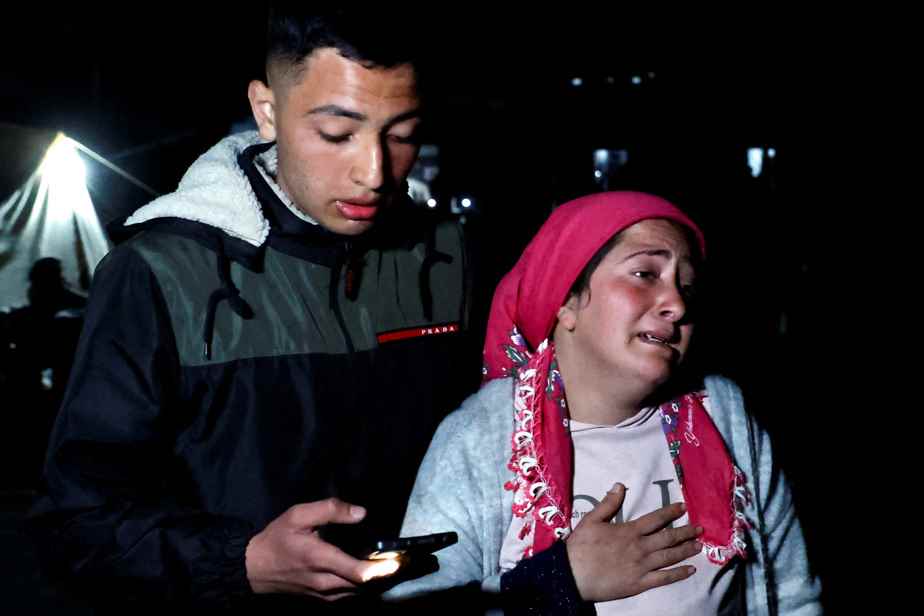(Antakya) Two strong earthquakes (6.4 and 5.8) once again shook northern Syria and the Turkish province of Hatay (south), the most affected by the February 6 earthquake on Monday evening. killed more than 45,000 people in both countries.
There are at least three dead in Turkey, Interior Minister Suleyman Soylu announced in the evening. The Vice President, Fuat Oktay, had previously reported eight people injured by falling buildings already damaged.
In Syria, 47 people were injured in Aleppo, caught in a panic as they tried to flee, reported the agency Sana. The group of Syrian rescuers of the White Helmets evokes more than 130 wounded in the north of the country.
The first quake, of magnitude 6.4 and with epicenter Defne, a district near Antakya (Turkey), occurred at 8:04 p.m. (12:04 p.m. Eastern time) and was very violently felt by the teams. AFP in Antakya and Adana, 200 km further north.

PHOTO YASIN AKGUL, FRANCE-PRESSE AGENCY
In Antakya too, the quake sparked panic among the already hard-hit population and raised large clouds of dust in the ruined city.
It was followed three minutes later by a new earthquake of magnitude 5.8 in Samandag, a coastal locality further south.
According to the Turkish relief agency Afad, at least two other tremors of magnitude 5.2 occurred in the evening. “Aftershocks along the Anatolian fault” and not new “independent earthquakes”, specified the Dr Övgün Ahmet Ercan, geophysical engineer.

PHOTO LOUAI BESHARA, AGENCE FRANCE-PRESSE
The tremors were also felt in the region of Aleppo, in northwestern Syria, reported AFP correspondents on the spot who saw the panicked population leaving their homes and going out into the streets.
Iskenderum Port Public Hospital and Mustafa Kemal University Hospital in Antakya were evacuated as a precaution, DHA news agency reported, and intensive care patients transferred to a field hospital. The Afad relief coordination center was also evacuated.
An alert for risk of submersion on the Turkish coast was issued, before being lifted.

PHOTO CLODAGH KILCOYNE, REUTERS
The first quake, of magnitude 6.4, whose epicenter was located in Defne, a district about fifteen minutes by car – in normal times – from Antakya, occurred at 8:04 p.m.
“The Earth Opening Up”
In a square in the center of Antakya, Ali Mazloum, an 18-year-old Syrian, testified to AFP about the intensity of the earthquake. “We were with Afad, which is looking for the bodies of our relatives when the earthquake surprised us. You don’t know what to do,” he said.
“We grabbed each other and right in front of us the walls started to come down. It felt like the earth was opening up to swallow us up.”
Ali, who has lived in Antakya for twelve years, is still looking for the bodies of his sister and her family, as well as those of his brother-in-law and his family who have disappeared since the February 6 earthquake.
“The road moved like waves, the cars tossed from left to right. The building was moving, back and forth. It cut our legs,” Mehmet Irmak, 34, employed in a notary’s office, told AFP.

PHOTO CLODAGH KILCOYNE, REUTERS
Not far away, a backhoe loader with full headlights was busy clearing an avenue of two lanes, covered with rubble.
“Hatay is no longer a safe place now… I’m going to wait for daybreak, but I don’t know what I’m going to do,” adds the man who had been sleeping in his car for two weeks following the first earthquake.
In Antakya, a search team was still working around midnight (local time), lit by powerful searchlights, to rescue residents who had probably come to collect belongings from their homes when the earthquake occurred.
Their small white two-storey building, in which the noise of the rescuers’ jackhammer is now heard, has given way. The two buildings surrounding it are also destroyed.
President Recep Tayyip Erdogan visited Hatay province on Monday, one of only two with Kahramanmaras affected by the earthquake two weeks ago where research and excavations are continuing.
They were arrested everywhere else on Sunday and the hope of finding survivors is almost nil. According to Mr. Erdogan, more than 118,000 buildings have been destroyed or badly damaged.
Previously, the head of state had spoken for more than an hour in Ankara with the head of American diplomacy Antony Blinken, who thus ended a two-day visit to Turkey.
The latter showed the support of the United States for the battered country, and promised to continue to provide assistance, while also wanting to be reassuring about the state of bilateral relations, which are sometimes tense.
